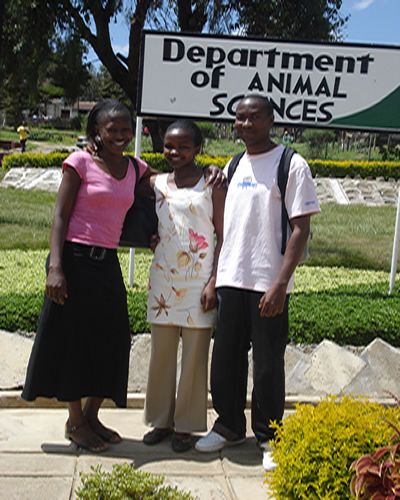Project details
Formal and informal supply chain projects
Project 2
Project Title
VALUE CHAIN ANALYSIS OF TOMATOES
IN THE GREATER NAKURU DISTRICT

Students undertaking the project (L - R): Beatrice Mwenesi, Sophia Ochiki and Sebastian Nduva
Project background
The tomato is a warm season crop thriving between temperatures of 21-240C. The mean temperatures below 160C and above 270C are not desirable. They grow on altitudes between 1000-2000 meters a.s.l. They require well drained sandy loam soils and rainfall of between 600-1200 mm per annum. They are mainly propagated using seeds in the nursery then later transplanting in the fields. A major problem is losses of about 50% both in quality and quantity between harvesting, transportation and consumption of fresh tomato i.e. through the value chain. Owing to lack of information on appropriate post harvest treatments, packaging, temperature, etc, the fruits not only lose their quality but also encounter a substantial post harvest loss. Production inefficiencies and inaccessibility to markets is another constrain to the tomato sub-sector. Increasing demands from traders and rising imports of tomato products combine to make marketing of tomatoes a daunting challenge to small holder farmers in Nakuru. Lack of secured ready markets for tomato produced in Nakuru is a concern to most farmers who run into debt. Seasonal variations in climate cause an irregular supply of the fresh tomatoes. Also diseases like blight, viruses, and mildews among others affect the industry negatively. Hence mapping out the chain will help us to identify issues that may be hindering or enhancing the functioning of the chain and also the institutions and organizations providing the services (e.g. market information, quality standards) that the different chain actors need in order to make better informed decisions.
Project Justification
Growers are exploited by middle men in the value chain due to lack of market information. Also losses both in quality and quantity do occur and this reduces their returns as has been reported. These losses abound in the different stages as the tomato moves from grower to consumer. Besides mapping out the value chain of tomato in the region, the study will also be beneficial in identifying ways of minimizing losses as well as identifying the strengths and opportunities that farmers can exploit to maximize on their profits.
Specific Learning Outcomes expected from participants on completion of case study
The overall objective of the study is to investigate the value chain of tomato from the producer level to consumer level and how profits can be maximized for the growers. The specific objectives are to have determined:-
- The key players in the value chain from grower, broker, trader up to consumer.
- Ways of reducing quality and economic losses in the value chain.
- Ways in which more profits can be channeled to the grower by cutting down the on the players along the value chain.
Status
Funded: On-going